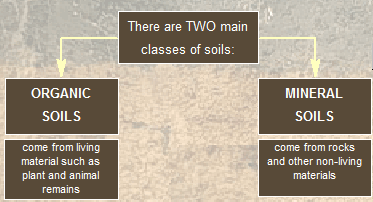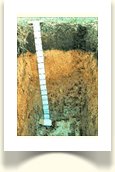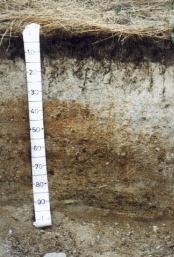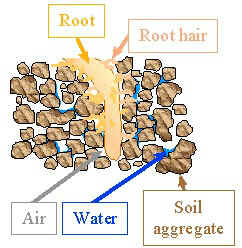Soil is not simply powdered rock or the top ten centimetres of the ground surface.
Soil is the loose collection of broken and chemically weathered rock mixed with organic and living matter on the earth's surface capable of supporting plants.
Any discussion about soil typically refers to that zone of biologically active and altered material that extends down to about one metre below the ground surface.
Ease:
Ease with which soils break into natural aggregates.
Structure:
Structure or size and shape of soil aggregates and the spaces between them.
Texture (sand, silt and clay content):
Contrasts in texture are common in soils formed from alluvium where watercourses have deposited layers of sand and silt. Varying texture with depth usually indicates a soil may have formed from one or more materials.
SOIL PROPERTIES:
SOIL DEFINITIONS:
Soil Colour:
Soil Colour:
Soil colouration mainly comes from the presence of iron (II) ions (Fe2+).
These ions are coloured brown and form from iron (II) ions (Fe2+) when oxygen is absent.
Iron (II) ions are virtually colourless - soils that lack oxygen (ie are poorly drained) are therefore pale in colour.
Well drained soils are typically a brown 'rusty' colour - all the iron is in the form of Fe3+.
Pale Soils:
This silt loam shows two distinct zones of aeration:
1. topsoil and upper subsoil. Topsoil is dark principally because of organic matter, upper subsoil because of iron (III) ions (Fe3+).
2. lower subsoil. Light because of poor aeration due to high water table (poor drainage). Iron in the form of iron (II) ions (Fe2+).
Mottles:
Mottling is the name given to spotted or streaked areas of colour (mottles) in soil. Mottling is usually associated with periodic wetting.
The clay loam shows two distinct zones of mottling:
1. upper subsoil - high degree of fluctuation in water table, lots of mottling
2. lower subsoil - less fluctuation in water table. Zone would typically be below the water table.




There are a number of important soil properties:
 |
ease , |
 |
structure, |
 |
consistency, |
Soil scientists are able to make a number of interpretations based on soil properties:
 |
soil colour is used to give an indication on the drainage state of the soil, |
 |
the structure of a soil, combined with the ease with which a soil is dislodged from a soil profile, indicates rooting depth of plants and rate of water movement. |
Consistency or looseness/firmness.
Colour of Soils:
With mineral soils, the topsoil is often dark in colour, due to partially decomposed organic matter from plant and animal remains known as humus. Below the topsoil is the subsoil, which may be various colours such as red, yellow, white, brown, orange or even blue. The upper half of the subsoil often differs in colour from that of the lower half. Subsoil may also have mottles or blotches of another colour through it.
Chemical and Physical Properties:
These usually require laboratory procedures for analysis. Results of such analysis can be used to make statements about soil nutrient levels and likely responses to land use.
Soil Structure:
The illustration shows aggregates arranged in the soil. Spaces between aggregates are important for root penetration, storing water and allowing aeration and drainage.
 |
texture, |
 |
colour of soils, |
 |
chemical and physical properties. |